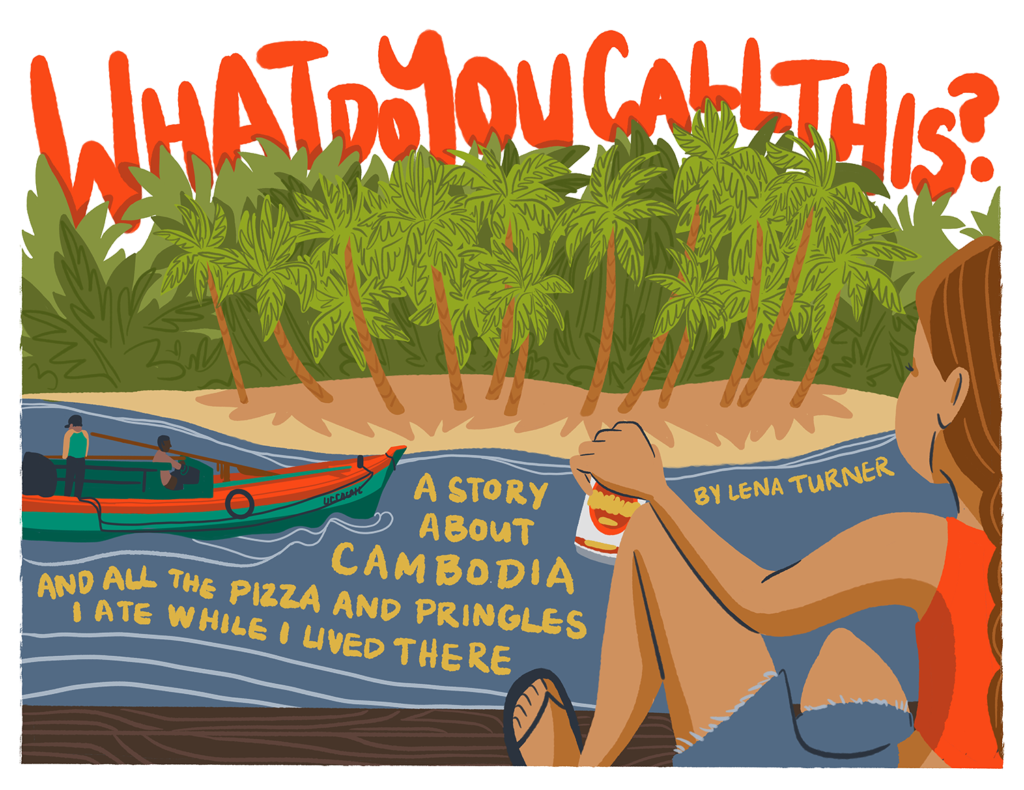
I first learned of Angkor Wat, a temple complex spread over 400 acres in the Cambodian jungle, during an Asian Art History lecture in college. I knew nothing of the country, it’s culture, politics, food, customs, ethnic makeup or even the location. When I saw those pictures projected onto a whiteboard in that dark classroom, however, I made a promise to myself that I would find that jungle and see those glorious temples with my own two eyes.
Ten years later, in the space of two months, I ended a relationship, totaled my car, and killed my cat. That seemed as good a time as any to make good on that promise. So, I bought a shockingly cheap flight to the other side of the globe and spent the weeks leading up to my departure scanning blog posts and top ten lists. Widely traveled and well documented, Thailand and Vietnam had some serious allure, but I was determined to go to Cambodia.
My date of departure arrived and after 14 hours in the center seat (is that why my flight was so cheap?), I stepped into a thick, hot Cambodian evening. There are many things about that first night in Cambodia that I’ll never forget: the cloud of bugs buzzing around every lamp from the plane to the airport building; my first of many “special” experiences with Cambodia border control; and very fondly, that first tuk-tuk ride that pulled me into my new life as yet another tourist in South East Asia.
Ten years later, in the space of two months, I ended a relationship, totaled my car, and killed my cat.
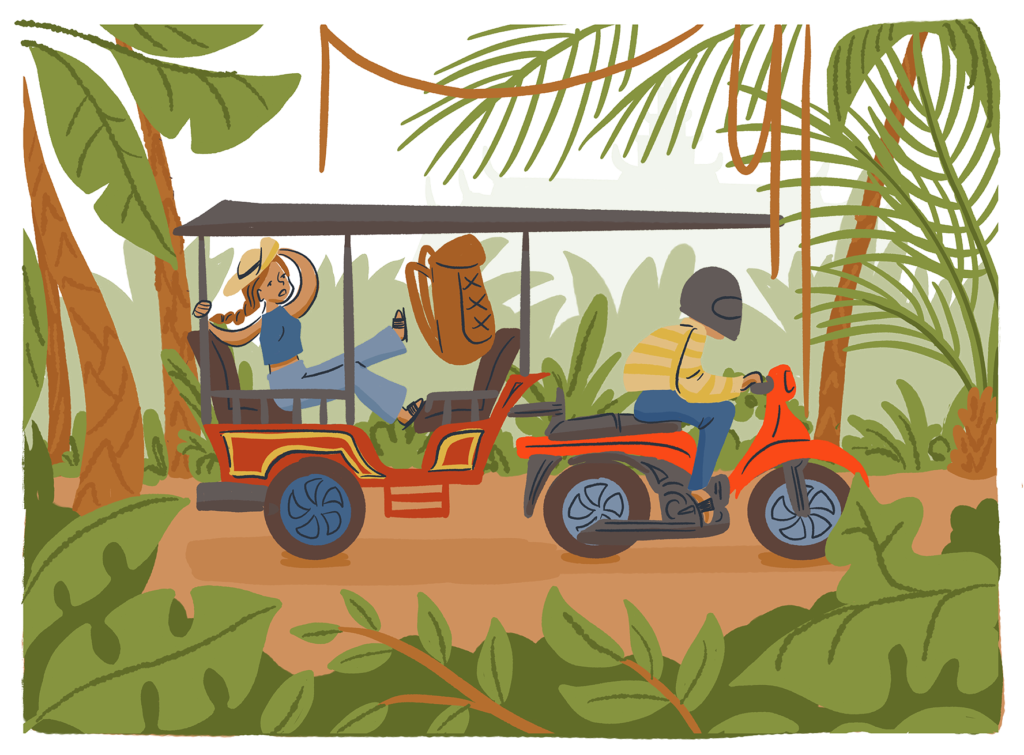
To me, everything was new. It was almost too much for my travel weary senses to take in.
(If you’re not familiar with what I’m referencing to, I’ll spare you the misinformation that I would undoubtedly spew—newsflash: have been spewing—just google the Khmer Rouge or watch that movie Angelina Jolie made or read the book or watch The Killing Fields or whatever, but prepare yourself. The horrific things that occurred relatively recently in this beautiful and mind-bogglingly friendly country’s history are truly crushing.)
My driver had gotten the time mixed up and the poor guy had been waiting at the airport for 5 hours! Passenger finally acquired and dinner waiting at home, he tore down a highway that was one or two rainy seasons away from becoming one big pothole. He zipped around giant trucks, through swarms of motorbikes, past makeshift roadside barbershops, a butcher shop of the same fashion, Buddhist temples, stand after stand selling every product ever manufactured, and families gathered around tiny plastic lawn furniture in front of their homes. It was late but people of all ages were out! And to me, everything was new — the way the air felt and smelled, the way people sounded, the way buildings stood, the way businesses conducted themselves. It was almost too much for my travel weary senses to take in.
So, I took it in slowly. Before venturing outside town to see Angkor Wat, I spent plenty of time soaking up Siem Reap, where I looked, listened, ate, and drank. I can’t say it struck me at the time, but I was wading through scores of pizza places, loads of Thai food, burgers joints, smoothie-bowl-vegan cafes, taco shops, Chinese noodles and dumplings, Pho, grilled meat skewers, and schnitzels everywhere. Did I mention pizza? Where was the “authentic” Cambodian food? Was it hidden from me because I was a tourist? Did I need to make friends with some Khmer people to find it?
Sure, I came upon some distinctly Khmer dishes here and there. Fish Amok, a mild coconut curry often served in a banana leaf; Kep crab with Kampot pepper; and Loc Lac, a salty, peppery stir-fried beef dish with huge slices of bafflingly raw white onion. There’s also a noodle soup that is indiscernible from cup-o-noodles and often is cup-o-noodles. And blended fruit drinks galore (not sure how Khmer that is so much as tropical). Oh, and bugs are a thing. A remnant of recent hard times, I think. Though, those could just be for us barangs. We’ll never know.
One evening, after I had been living in Cambodia for a few months, I was invited to dinner at my Khmer neighbors’ house when I had the pleasure of trying Prahok for the first time. Also coined Cambodian cheese, it isn’t cheese at all but fermented fish paste. I can do fermented shit and I love fish, but when something is billed as Cambodian cheese and then, upon entry into your mouth hole, explained as fish paste, your taste buds can’t be catfished more than that. I shudder even now remembering my attempt at composure while being jilted by my one true love — cheese.
There are other dishes that I’m sure I’m forgetting or simply didn’t try, but from my vantage point, it appeared that cheap, processed foods and foreign foods were consumed in Cambodia as much, if not more-so, than anything distinctly Khmer. I will, however, qualify everything I’m saying by acknowledging that I have no idea what I’m talking about.
Two weeks after my arrival, when I finally made the trip to Ankor Wat, I didn’t make it easy for myself. Most tourists hire a tuk-tuk to take them the four miles from town to the temples, and the several miles around the site, but I am not most tourists. I have an undying love for doing things the hard way. It’s this love of inconveniencing myself that has taken me to less tried and true countries while traveling. When I went to Europe, it’s what drew me to the Balkans, into the mountains of Slovakia, to the Middle East solo, into interior Greece, rather than the Islands. And, while in Cambodia, this love compelled me to visit the massive temple complex of Angkor Wat by bicycle.
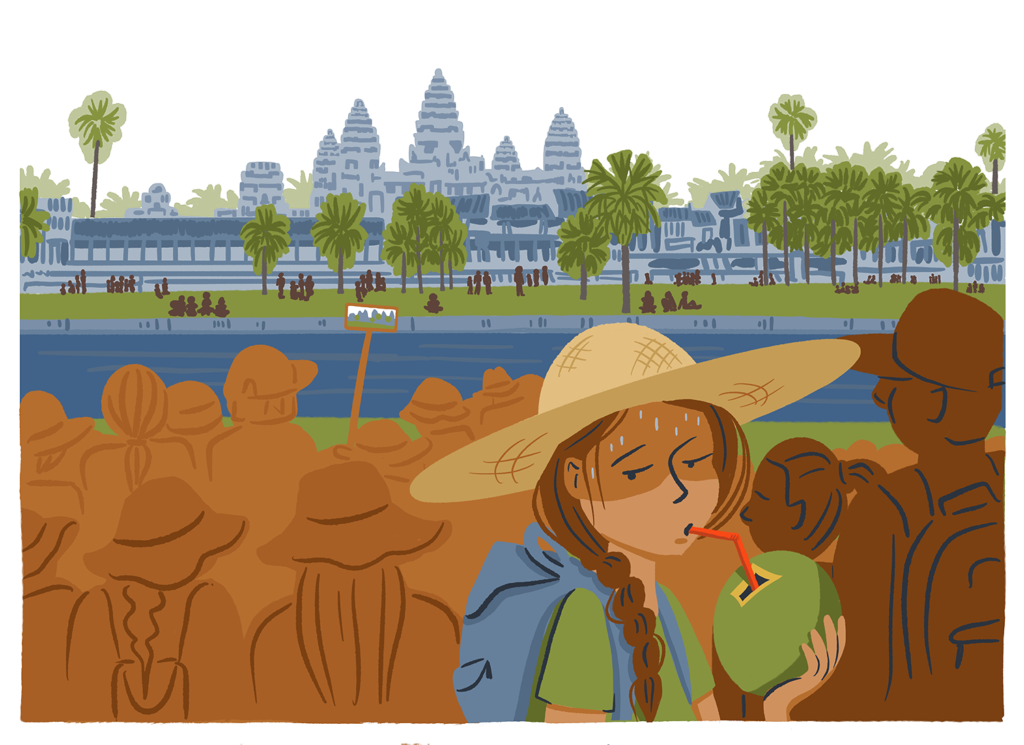
It was there that I witnessed first-hand all the splendor and seediness of life as an expat in South East Asia.
I rented a bicycle the night before and the next day set off just as the sun was coming up. After getting lost, back-tracking, and unwittingly using a side entrance, I finally arrived by the strength of my two legs. I was exhausted but still blown away by the glory of that site and also by the staggering number of tourists also being blown away by the glory of that site. After a few hours of milling around the crowded temple complex, I remembered how much I hate being a tourist. So, I did what any sane person would do when faced with tourist burn-out two weeks into her trip: I moved there instead. Or, I guess, stopped moving, and dispensed of all plans to leave. Out of sheer laziness, and perhaps the prospect of living like a queen in a tropical paradise for very little money, I went from tourist to expat — which doesn’t make a ton of sense, because living in Cambodia really isn’t convenient at all.
I didn’t move to Siem Reap, but instead headed South and found a much smaller town near the coast. I quietly inserted myself into a community of expats who were friendly — at first. They were too accustom to transient friends to warm past acquaintanceship very easily. It was there that I witnessed first-hand all the splendor and seediness of life as an expat in South East Asia. A life that attracted all manners of persons — nomads, NGO workers, sex-pats, missionaries, activists, tour guides, backpackers, seasonal workers, yoginis, artists, musicians, business owners, volunteers, retirees, and drifters. All of whom shared two common interests: drinking and avoiding life back home. Okay, that’s a gross generalization. Actually, the only thing this varied collection of humans from all over the world did have in common was this beautiful, broken country they now called home.
I did my best to fit in. I bought a motorbike, oozed disdain on tourists, started doing yoga, became a fixture at my local wine bar, learned some Khmer and called everyone “bong” (friend in Khmer). It was a good life, for a time.
My extended stay in Cambodia was sandwiched between two short stays in Vietnam and Thailand, countries whose culinary landscapes are rich, distinctive, and iconic. Cuisines which can be found all over the world. Cuisines that I could grasp and define even before having set foot in either country. When it comes to Cambodia, however — even after all those months and all those meals — the food still eludes me. But why? Are Thai and Vietnamese cuisines easier to define than Cambodian cuisine because they were less foreign to begin with?
Maybe I’m ignorant — and surely ill-informed — but, I think there’s more to it than that.
Many dishes I encountered regarded as “local” seemed rather — how do I say this politely — borrowed. The steamed buns they sell on the streets? Chinese. The curries? I mean, everyone does curry, and again I’m no expert, but…Thai? Speaking of which, can we talk about green mango salad? Who wore it first? Mango or papaya?
I think the impact of foreign influence on modern Cambodian cuisine is pretty undeniable. Not that there is anything wrong with that, I’m American for fucks sake! Everything we’ve got is borrowed! But also, we’re 8 year-olds in the scheme of world cultures. We’re over here putting potato chips on our peanut butter and jelly sandwiches, while Cambodia is literally ancient. It’s home to the resplendent, aforementioned temples. It’s the goddamn Kingdom of Wonder, and with such culinarily revered neighbors, you know, it kind of makes you wonder. Where is the authentic, traditional Cambodian food of old?
Well, it makes me wonder. I saw items on the menus of “Cambodian” restaurants that would easily fall on different ends of the appropriation spectrum. Or is that just globalism? And is a place like Cambodia especially susceptible to it’s influence because of the now infamous and relatively recent genocide? An event so devastating, the ramifications of which are still being felt today, 40 years later. (see sidebar)
Was Cambodian cuisine also a victim of the Khmer Rouge’s horrific genocide? Eek, sorry, is that too real? Well, in the wake of a tragedy that wiped out a quarter of the population, it’s not a stretch to imagine that, in addition to lives, a large portion of food culture was also lost.
(If you’re not familiar with what I’m referencing to, I’ll spare you the misinformation that I would undoubtedly spew—newsflash: have been spewing—just google the Khmer Rouge or watch that movie Angelina Jolie made or read the book or watch The Killing Fields or whatever, but prepare yourself. The horrific things that occurred relatively recently in this beautiful and mind-bogglingly friendly country’s history are truly crushing.)
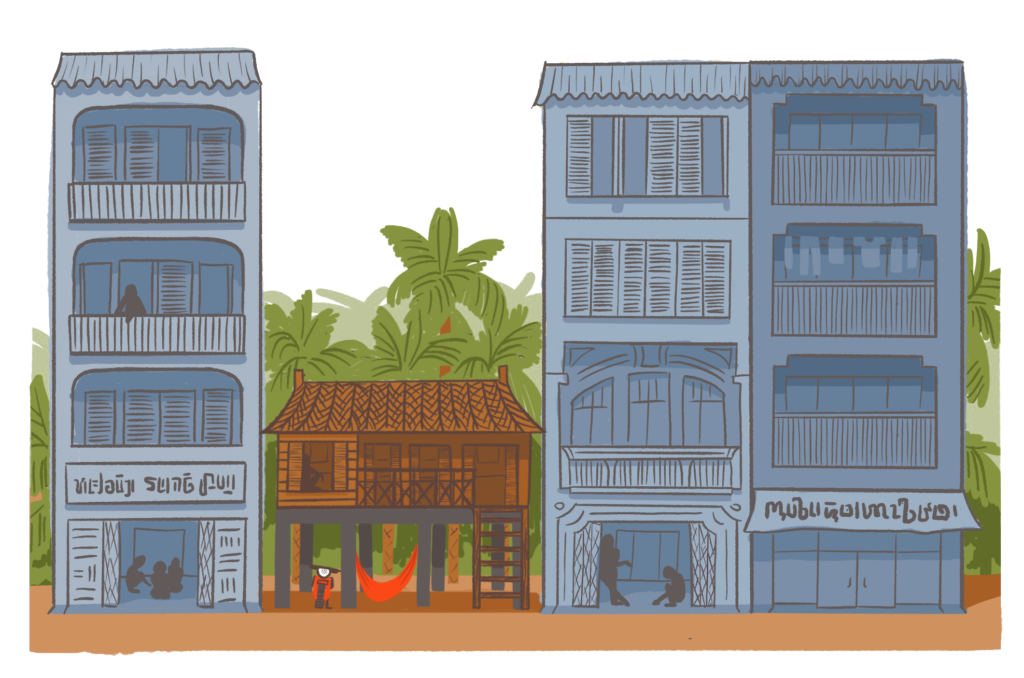
I’m not wondering about the blog-post-proliferated, must-try dishes or the upper-class foods or special occasion dishes that have persisted, I’m wondering about the stuff that normal people ate on a regular basis. The stuff that has since been replaced by cheaper flavor-engineered foods. Before China started buying the whole country and mega food conglomerates filled it with fake Pringles and cup-o-noodles.
Are food traditions being lost or diluted as Cambodia gets parceled off to the highest bidder? Is traditional cuisine drowning under waves of globalization or getting swept aside by the changing tastes of a population whose average age is 24? Or did it travel with the immigrants and refugees?
On a hazy evening, over beers, I was invited on an adventure by a fellow expat. Stefan was an older French Roma man who was truly and inspiringly adventurous, and he had the too-wild-to-be-made-up stories to prove it. Since he had only a semblance of an ability to speak English himself, he needed the assistance of a native speaker (me) in his English classes to lend credence (I realized after the fact) to his farce as English teacher. So, the next day, I hopped on the back of his dodgy Honda Wing and we rode into a neighboring village. Before class, we stopped at an outdoor café for a morning beverage. There was only one thing being served, iced tea, and it was delicious. I asked what type of tea I was drinking, in hopes of finding something unique to Cambodia. A game of charades ensued and, with the help of Stefan’s better-than-broken Khmer, the shop-owner produced a tin of tea that, upon visiting Cambodia’s neighbor to the West, I found to be the same brand of tea responsible for the sweet, creamy, orange beverage so associated with Thailand.
Next, however, we went to a very local joint for breakfast — an improvised restaurant on the ground floor of a Khmer home. Baby plastic lawn furniture was set up in the open-air front room of this family home as had likely been done for years. You could tell the same faces filled the place week after week — faces that curiously eyed two white people sitting down to a humble and very classic Khmer breakfast. We were presented with two heaping plates of rice topped with some squiggles of pan-fried pork slices and a few cucumber medallions. The best part of the dish came on the side — rings of red chilis floating in a tiny saucer of dark, salty, sour, sweet, funky sauce. It was simple, filling, and delicious.
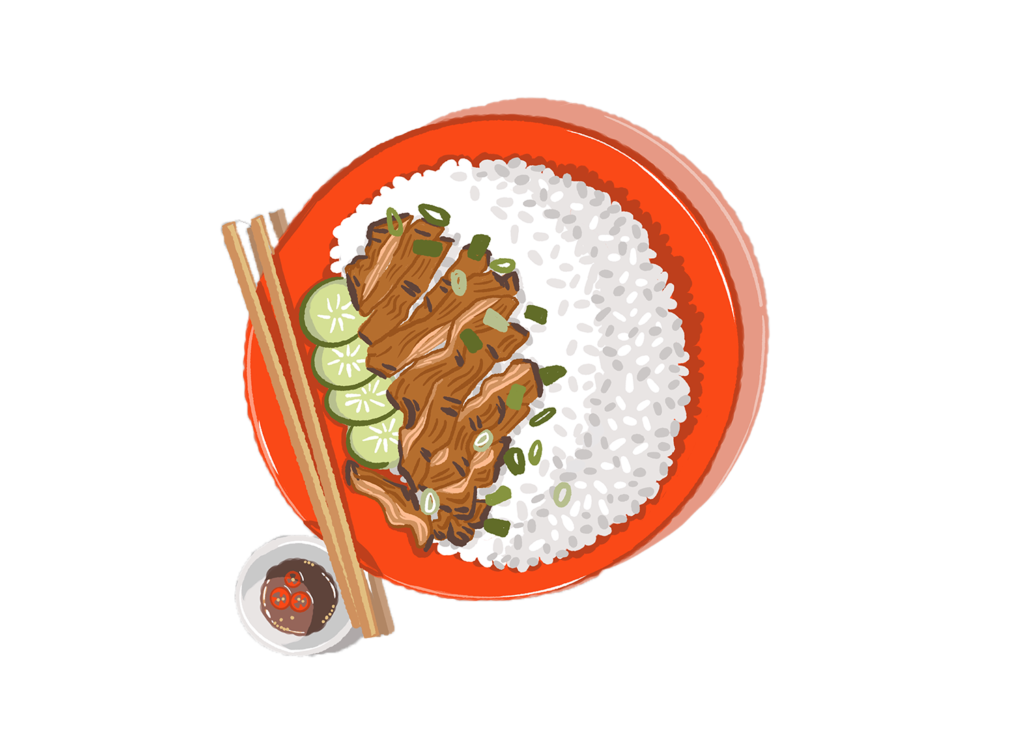
Eating that pork and rice in that family’s front room, sharing a meal with my Khmer neighbors, and each time I visited the open-air market in town, I felt I was getting a little glimpse at something behind the curtain. You’d think that after living there for a year, I’d have a good sense of what Cambodian food is, but I can’t honestly say that I do. I have this nagging feeling that in addition to the holes in my knowledge of Khmer cuisine, there are actual holes in Khmer cuisine.
I don’t know how much was lost during the Khmer Rouge years, and I don’t know how much of this is just me being another asshole living in Cambodia for all the wrong reasons. But what I do know, is that flights to South East Asia are super cheap and Cambodia and it’s people are amazing, but I’ve played Dengue roulette for far too long already, so if someone with more gumption wants to pop over and get to the bottom of this for me it would be much appreciated.
It was there that I witnessed first-hand all the splendor and seediness of life as an expat in South East Asia.
Contributors : Lena Turner